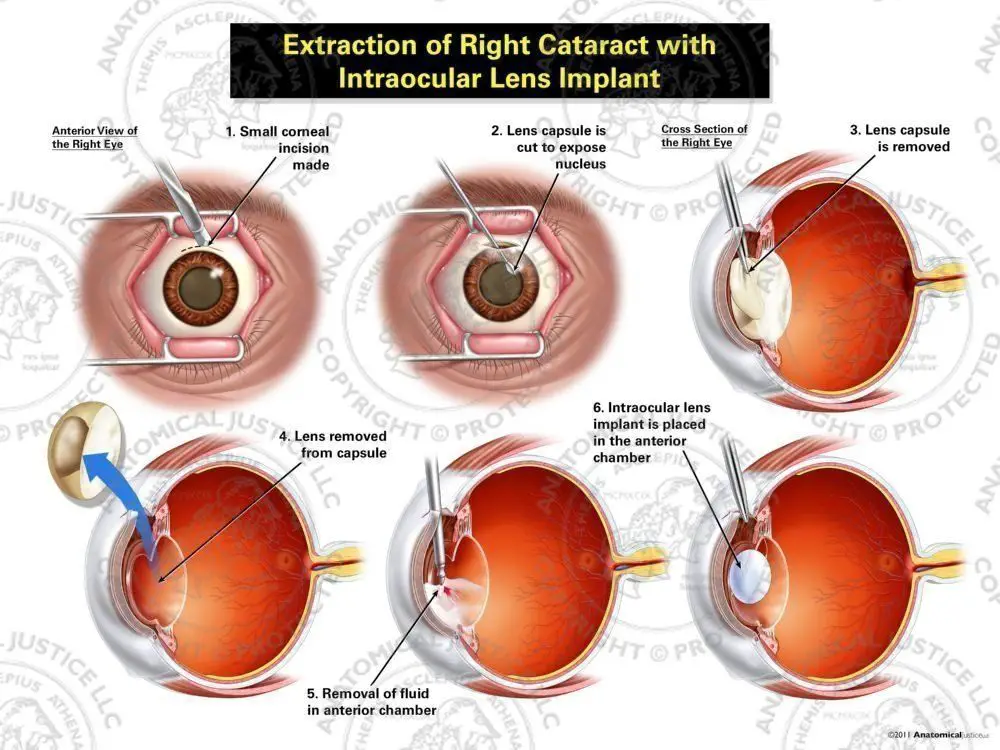A cataract is a clouding of the lens in the eye that affects vision. As people age, the lens of the eye can become cloudy and harden, causing blurry vision, faded colors, poor night vision, and glare from lights. Cataracts usually develop slowly and painlessly. Cataracts are extremely common, especially in older adults. According to research, by age 80, more than half of all Americans either have a cataract or have had cataract surgery.[1]
Cataract surgery is a procedure to remove the clouded lens and replace it with a clear artificial lens implant to restore vision. Cataract surgery is very common and is considered safe and effective, with over 98% of patients experiencing improved vision after the procedure.[2] Medicare covers standard cataract surgery, but certain types of specialized or premium lens implants may not be covered.
[1] https://www.nei.nih.gov/learn-about-eye-health/eye-conditions-and-diseases/cataracts/cataracts-facts
[2] https://www.aao.org/eye-health/diseases/what-is-cataract-surgery
Overview of Cataracts

Cataracts are a clouding of the natural lens in the eye that affects vision (https://www.aao.org/eye-health/diseases/what-are-cataracts). The lens is normally clear, allowing light to pass through and focus on the retina to produce a sharp image. With cataracts, the proteins in the lens start to break down and clump together, causing the lens to become cloudy or opaque. This prevents light from properly passing through to the retina, resulting in blurred vision.
Cataracts typically develop slowly over time and can affect one or both eyes. The cloudiness usually starts in the center of the lens and spreads outwards. Common symptoms include blurred vision, faded colors, halos around lights, difficulty seeing at night, and sensitivity to glare (https://www.nei.nih.gov/learn-about-eye-health/eye-conditions-and-diseases/cataracts).
The most common causes of cataracts are aging and exposure to ultraviolet radiation. Other risk factors include smoking, diabetes, certain medications, and eye injuries. Cataracts affect over 24.5 million Americans age 40 and older (https://www.nei.nih.gov/learn-about-eye-health/eye-conditions-and-diseases/cataracts). They are the leading cause of vision loss in people over age 40.
Treatments for Cataracts
Cataracts are a clouding of the natural lens in the eye that affects vision. As cataracts progress, they can significantly impair vision and impact daily activities. While cataracts cannot be reversed, there are treatment options available.
The most common and effective treatment for cataracts is cataract surgery. This procedure involves removing the cloudy natural lens and replacing it with an artificial intraocular lens (IOL). The surgery is done on an outpatient basis and involves making tiny incisions in the eye to break up and remove the clouded lens using an ultrasound probe. Once removed, the surgeon inserts an IOL in its place. IOLs provide clear vision and can correct astigmatism and nearsightedness. Cataract surgery has a high rate of success in restoring vision.
Other options besides surgery include stronger eyeglasses, anti-glare sunglasses, brighter lighting, and medication such as eye drops. However, these only temporarily improve vision and do not address the progression of the cataract. They are often used while waiting for cataract surgery.
Some emerging treatments show promise in slowing the progression of early cataracts and reducing cloudiness. These include eye drops containing lanosterol and peptides applied directly to the eye. However, these are still undergoing testing and are not widely used treatments yet. They may help delay cataract surgery but are not a cure.
In summary, cataract surgery with intraocular lens implantation is the most effective treatment for restoring vision obscured by cataracts. Other options can temporarily improve vision but do not treat the underlying cause.
Medicare Coverage for Cataract Surgery
Medicare provides coverage for cataract surgery for beneficiaries who meet certain criteria. In general, Medicare Part B covers a portion of the costs for cataract surgery, including the surgeon’s fees, facility fees, anesthesia fees, and the artificial lens implanted during surgery. There is typically a 20% coinsurance that the patient is responsible for after Medicare pays its share.
For a patient to qualify for Medicare coverage of cataract surgery, the ophthalmologist must document that the cataract is interfering with the patient’s vision and ability to perform activities of daily living. Medicare has specific guidelines on the level of visual impairment required to approve surgery, including decreased visual acuity and functional impairment. The doctor must submit documentation about the patient’s visual symptoms and cataract severity.
In addition to the cataract criteria, the surgery itself must be performed at an approved facility using approved methods in order for Medicare to cover the procedure. The most common type of cataract surgery covered is phacoemulsification, which uses ultrasound waves to break up the cloudy lens and insert an intraocular lens implant. This standard cataract surgery is fully covered.
Medicare Part B covers one pair of eyeglasses or contact lenses after cataract surgery to correct vision problems related to the implanted lens. Medicare will also cover treatments for complications that arise during or after cataract surgery that are directly related to the procedure.
In general, Original Medicare provides robust coverage for standard cataract removal and implantation of a basic monofocal lens for beneficiaries who meet the medical necessity criteria. However, there are some exclusions and limits on more advanced cataract surgeries and lens options.
Types of Cataract Surgery Not Covered
There are a few specific types of cataract surgery procedures that are not covered by Medicare:

Multifocal IOL Implantation – This involves implanting a multifocal intraocular lens (IOL) during cataract surgery. Multifocal IOLs correct both near and far vision, reducing the need for glasses or contacts after surgery. However, they are considered an upgrade and are not covered by Medicare.[1]
Toric IOL Implantation – Toric IOLs are designed to correct astigmatism as well as cataracts during surgery. Like multifocal IOLs, toric IOLs are considered an elective upgrade and are not covered.[1]
Laser-Assisted Cataract Surgery – This uses a femtosecond laser to perform parts of the cataract procedure, including the incisions and lens fragmentation. It is an advanced technology not covered by Medicare.[1]
These upgraded options provide benefits like reduced dependence on glasses, but come at an additional out-of-pocket cost for patients.
Costs of Non-Covered Cataract Surgery
Patients will have significant out-of-pocket costs if they undergo cataract surgery that is not covered by Medicare. According to this study, the cost of multifocal intraocular lenses (IOLs) for bilateral implantation can range from $2,300 to $3,600 based on patient payments. Since Medicare does not cover these upgraded IOLs, the patient must cover the full cost. Another analysis found that multifocal IOLs had an incremental cost-effectiveness ratio of $34,000 per quality-adjusted life year compared to standard monofocal IOLs covered by Medicare. With monofocal IOLs fully covered, patients who choose multifocal or other upgraded IOLs must pay approximately $3,400 out of pocket on average for the surgery.

Other non-covered services like laser-assisted cataract surgery can cost an additional $1,000 or more per eye. Combined facility fees, surgeon fees, and the non-covered technology can lead to thousands of dollars in bills for patients who choose cataract surgery not covered by Medicare.
It’s important for patients to understand these costs and prepare for significant out-of-pocket expenses if they wish to undergo cataract surgery with non-covered enhancements. Careful consideration of the benefits and financial impact is necessary.
Considerations for Non-Covered Surgery
When considering non-covered cataract surgery, it is important to weigh the potential benefits and risks. One of the main benefits of non-covered options like multifocal IOLs is improved vision quality. As explained by OA Vision (https://oaveyes.com/blog/what-are-the-advantages-of-multifocal-iols), multifocal IOLs can provide crisp vision at varying distances, reducing or eliminating the need for glasses or contacts after surgery. Envision Eye Care (https://www.envisioneyecarepa.com/resource/eye-resources/multifocal-intraocular-lens-implants/) notes that multifocal IOLs allow cataract patients to become less dependent on corrective lenses.
However, there are some risks to consider as well. Multifocal IOLs may cause visual side effects like halos or glare around lights at night. The surgery itself may also have higher risks than standard cataract procedures. Patients should think about whether the potential benefits outweigh these risks given their lifestyle and visual needs.
Alternatives to Non-Covered Surgery
Even though Medicare does not cover certain types of cataract surgery like multifocal IOLs, there are some alternatives that patients can consider.
One option is to get monofocal or accommodative IOLs instead, which are covered by Medicare. As explained by Dr. Rex Hamilton (https://rexhamiltonmd.com/cataracts-los-angeles/multifocal-iols/), “The alternative to a multifocal lens would be a monofocal IOL or an accommodative IOL.” Monofocal lenses only correct for one focus distance, but they pose less risk of side effects like glare and halos.
Another alternative is financing options to pay for the non-covered surgery out-of-pocket. Many eye clinics offer payment plans or connections to medical lending companies. Patients can also use health savings accounts (HSAs) or 401k loans if eligible.
Overall, while Medicare has limits on coverage, patients still have options for cataract treatment. Consulting with an ophthalmologist and considering all alternatives can help patients make the best medical and financial decision for their vision needs.
Making a Decision
When considering cataract surgery, it’s important to weigh all of your options and choose the intraocular lens (IOL) that best fits your lifestyle and visual needs. Here are some tips for deciding on the right IOL option:

Discuss your daily activities and vision goals with your ophthalmologist. Let them know if you do a lot of reading, computer work, driving, sports, etc., as well as your preference for reducing or eliminating dependence on glasses or contacts after surgery. This will help determine if a standard monofocal, presbyopia-correcting or toric IOL is recommended.
Understand the benefits and potential side effects of each IOL type. While presbyopia-correcting and toric lenses offer reduced reliance on glasses, they may also increase risk of visual disturbances like glare and halos.
Consider your budget. While Medicare covers standard monofocal IOLs, you will likely need to pay out-of-pocket for presbyopia-correcting or toric premium lens upgrades, which can cost $1000-$3500 per eye.
Research patient satisfaction and visual outcomes. Presbyopia-correcting lenses provide good vision at near and far for many, but not all patients. Ask your doctor for success rates.
Have realistic expectations about your results. No lens can fully restore the youthful focusing ability of your natural lens or guarantee perfect vision.
Take time to make your decision and get a second opinion if desired. There is no “one size fits all” best IOL, only the option that is right for your eyes and lifestyle.
Conclusion
In summary, while Medicare covers standard cataract surgery to remove cataracts, certain types of premium cataract surgeries like multifocal IOLs or toric IOLs are not covered. These advanced lens implants aim to reduce dependency on glasses post-surgery but come at a higher cost. Before choosing an expensive non-covered surgery, carefully weigh the benefits and risks. Consider your lifestyle needs and eye health goals. While premium options can provide convenience and vision optimization, standard monofocal IOLs may still meet your needs at a lower cost. Discuss all options in-depth with your eye doctor to make the most informed decision.
In conclusion, make sure to explore your Medicare and supplemental insurance coverage. Look into payment plans or financial assistance programs if needed. While premium cataract surgeries can come with advantages, lens exchange surgery is not always necessary or advised. Prioritize your eye health first when planning for treatment.

